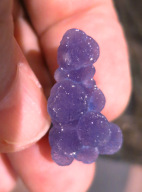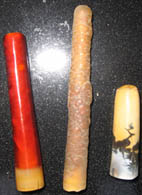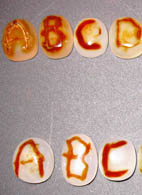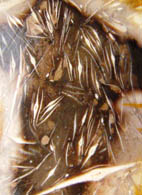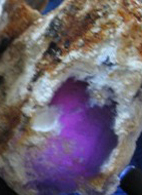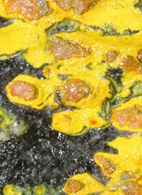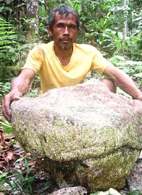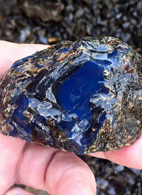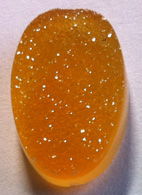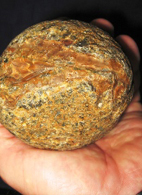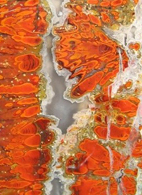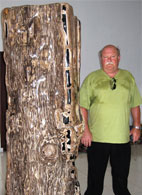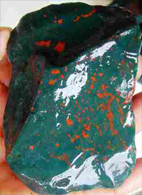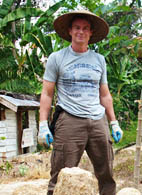
Figure 1: Drusy Fingers

Figure 2: West Java vs East Java Drusy
Indonesian Drusy has become hugely popular as an inexpensive yet brilliantly gemmy lapidary material. Over the last 10 years, a great industry has developed. Consumers are passionate about the glittery natural colors of Drusy, the electric intensity of metallic plated crystals & soft pastel colors of dyed stones alike.

Figure 3: Natural Drusy Cabs
 |
 |
|---|
| Figure 4: Dyed Drusy | Figure 5: Plated Drusy |
|---|
The word druse refers to an aggregate mass of small crystals (“crystal druse”). These crystal intergrowths or clusters can be formed by many different minerals. The gem & jewelry industry has adopted the term Drusy for cabs cut from crystal druses. Druses typically form in open space or cavities in rocks beneath the earth’s surface. The mineral species and shapes of crystals formed are dependent on fluid composition. Crystal size is a function of fluid temperature and pressure.
Druse accumulations which I have seen while working as a gold & copper exploration geologist in the field, were druses of garnet, calcite, pyrite, hematite (specularite), azurite, quartz, psilomalene, chrysocolla, siderite, fluorite and sphalerite. The list of possible minerals which form druses could go on and on, with even natural forms of house-hold compounds such as salts and sugars on the list.


Figure 6: Garnet druse Figure 7: Hematite druse
There are 7 different crystal systems under which crystals form, each resulting in different shaped crystals (http://en.wikipedia.org/wiki/Crystal_system). For example pyrite forms crystals under the “isometric” system. It forms cubes (6 sides), octahedrons (8 sides), dodecahedrons (12 sides, and trapezehedrons (24 sides). In nature, cubes are the most common.

Figure 8: Crystal Shapes
Quartz forms crystals under both trigonal and hexagonal systems, with 3 or 6 sided crystals being most common.
Compounds of SiO2 form 60% of the earth’s crust. Pure quartz is pure SiO2 (silicon dioxide) and is clear like glass. As quartz forms in nature, it can substitute other elements in its structure which impart other colors. We commonly call these impure forms of quartz by other names such as; Amethyst, Carnelian, Ametrine, Citrine, Rose Quartz, Fortification Agates, Chrysoprase, Chrysocolla, Opal and more.
The “Drusy” craze in Indonesia seems to have begun about 12 to 15 years ago. Villagers in the mountains of East Java began finding druse lined pockets in river gravel agates.
It turns out, the ancient marine sediments which form the rugged mountains in East Java have been intruded by volatile rich magmas which not only created world class deposits of copper and gold (Bukit Tujuh; 15 billion lbs of copper and 25 million Oz gold), the reactions of mineral rich hot fluids created ornate jaspers, moss & plume agates and fossils galore along with druse quartz filled geodes.
Village craftsmen would chip the ornate stones into rough shapes with small hammers. The shapes were then ground and polished into free-form cabs. Their tools consisted of strips of coarse to fine grit sandpaper glued to grinding wheels on electric motors anchored to blocks of cement poured in the dirt.
Today, East Java village workshops produce tens of thousands of cabs a month. Some workshops have been outfitted by overseas companies and now use calibrating equipment with diamond grinding wheels and drill with modern ultrasonic machines.

Figure 9: East Java Drusy cutters
When I first visited East Java, the hungry market in nearby Bali represented an opportunity to sell attractive agates or jaspers. There were not yet any cutters in Bali, just a mass of designers and silversmiths looking for stone to set. Indonesian stones were not yet recognized in Bali. Cabs were imported from India and China.
At the time, West Java already had a booming stone cutting industry which served the local markets in Jakarta and Bandung. Several workshops had gotten government grants to upgrade to electric saws and power tools.
We introduced crude rock saws to East Java villagers and provided cabs and templates from US cutters as examples of western styles of cutting.
The real boom in popularity of Drusy was created by mass marketers and designers who introduced jewelry lines using inexpensive altered stones to the public. The Chinese and Indians jumped on the band wagon and came out with similar products as well as their own variations.
Artificial coatings and dyed colors of Drusy quartz can be stunning. A number of companies have developed processes to plate colors onto the crystal faces using vaporized metallic compounds.
These coatings and dyes are popular for improving the less attractive colors of naturally brilliant druse crystal aggregates turning shades of gray and brown into “cobalt blue” and “titanium purple”.

Figure 10: Metal coated Drusy cab
The following year, while villagers were collecting materials from the initial find, the search continued for fossil coral. Not far away from the first palm field, another area was identified in which huge palm stumps up to 800kg were unearthed. These were unique in that the outer region (parenchyma cells) exhibited a coarse structured, birds-eye pattern and some of the inner cells representing the vascular bundles were replaced by blue agate.

Figure 11: Drusy cab dyed by absorbing colors into micro-pores
Absorption of a dye can highlight the natural botryoidal structure of the agate hosting the druse and add another creative dimension to the stone as seen in Figure 11.
Textile dyes are used in some villages and the colors can endure for years unless the stones are cleaned with the wrong solvent.
Even 100% natural quartz druse can lose is color after enough exposure to UV light. The expensive cathedral amethyst geodes placed in front of the Silom Galleria in Bangkok lost their rich purple amethystine color in only a few years of blistering Bangkok sunshine. Bleached out amethyst turns a dull gray over time and direct sun exposure speeds up the process.
I still prefer those druses colored by nature. Every stone is unique and different. Although perfect crystals and beautiful colors don’t often occur together, that combination is always a winner to me.
Most druse forms as cavity lining in geodes. The botryoidal agate mass of the geodes are irregular, lumpy like a cluster of grapes. As a result, typically the surface area for cutting a cab is small. Large stones are less common. Many cutters keep a border of plain agate around the druse covered area of the cab to produce larger cabs.
In most druse, the terminations of crystals appear random and stones glitter like a fistful of tiny diamonds as the viewing angle changes with movement. Some rare formations of druse occur in which the alignment of the crystal faces are uniform across the surface and the glitter turns to a flash.
Colors of natural druse vary widely and enhanced variations are infinite. Crystal druses of most mineral species other than quartz are rare, so >95% of the Drusy on the market is quartz.
Fortunately quartz and chalcedony readily invite other elements to merge in the crystal structure. The formation waters that contain dissolved compounds of iron, manganese, copper, zinc and other metals, impart wide ranging natural colors to the quartz crystal druse and offer the consumer a great selection of unique gems.

Figure 12: Indonesian druse colored by nature

Figure 13: Classic East Java druse rough

Figure 14: New West Java druse rough
The brilliance of West Java Drusy is hard to beat. The lapidary yield from thin sheets, pulled from hard volcanic source rocks is high. The trick is hand mining this gemmy material from hard rock without explosives which would shatter the matrix and crush the crystal faces. So be patient. This material is coming!


Figure 15: Hand cut Indonesian Drusy cab Figure 16: Dyed Drusy in Nate Sills design

Figure 17: Ronald Stevens gem carving from natural Indonesian druse rough

Figure 18: Natural color Indonesian druse

Figure 19: Random orientation crystal in West Java druse

